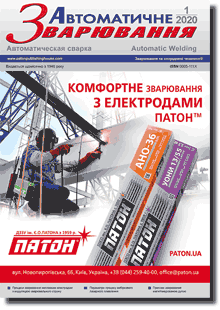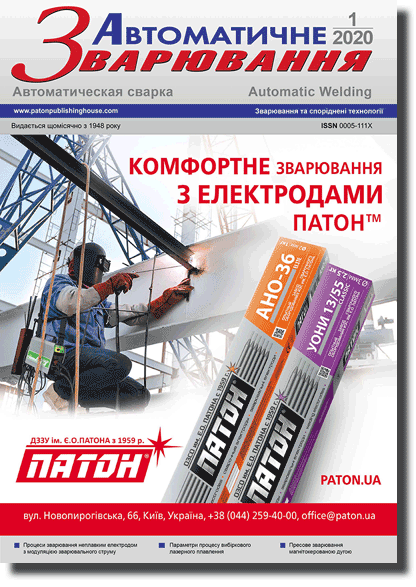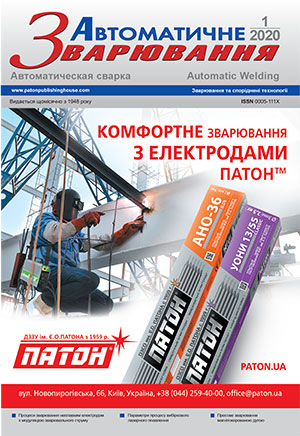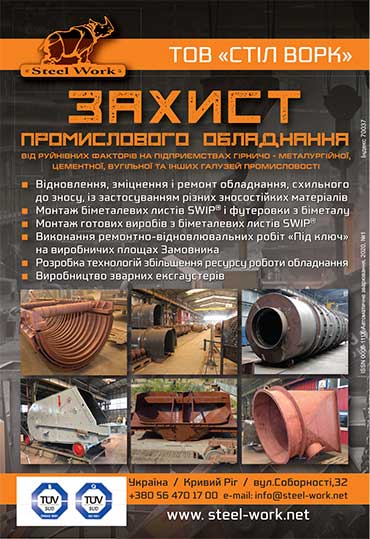| 2020 №01 (02) |
DOI of Article 10.37434/as2020.01.03 |
2020 №01 (04) |

"Avtomatychne Zvaryuvannya" (Automatic Welding), #1, 2020, pp.15-24
Impact of spatial position in laser welding on quality level of welded joints of AISI 321 steel
A.V. Bernatskii, V.D. Shelyagin, O.V. Siora, V.M. Sydorets, O.M. Berdnikova
E.O. Paton Electric Welding Institute of the NAS of Ukraine, 11 Kazymyr Malevych Str., 03150, Kyiv, Ukraine. E-mail: office@paton.kiev.ua
The objective of the study was determination of the impact of spatial position in laser welding of corrosion-resistant austenitic steel AISI 321 on the microstructure and quality level of welded joints. Penetration beads were made in plates of 3 mm thickness at different angles of inclination to the horizontal plane. «Uphill» and «downhill» laser welding was performed both in the continuous and pulse modes of laser radiation generation. Results of visual and radiographic testing and analysis of the data of metallographic studies were used for assessment of quality level of the produced samples for compliance with the requirements of valid standards. In «uphill» and «downhill» welding in the continuous mode of laser radiation generation no internal defects in the form of cracks, pores and inclusions were found at all the angles of inclination. A tendency to increase of both the quantity and size of pores at reduction of the angle of inclination from 90 to 0 deg was found in «downhill» and «uphill» welding in the pulse mode of laser radiation generation. By the data of metallographic studies, no significant differences were observed in the structure of welded joints made in different spatial positions on steel AISI 321 3 mm thick. At different values of the angle of inclination, the microhardness and dimensions of the crystallites differ by approximately 10 %. Contrarily, the shape of welds in the produced penetration beads differs quite significantly. Dependencies of quality characteristics of welded joints of AISI 321 steel in laser welding were derived for the first time for different spatial positions. Derived dependencies allow determination of the tendencies of the change of the shape and quality of welded joints at the change of position or technological parameters of laser welding process. 13 Ref., 2 Tabl., 6 Fig.
Keywords: laser welding; corrosion-resistant steel; heat-resistant steel; austenitic steel; technological parameters; spatial position; quality; structure; porosity
Received: 25.10.2019
References
1. Serdar, M., Meral, C., Kunz, M. et al. (2015) Spatial distribution of crystalline corrosion products formed during corrosion of stainless steel in concrete. Cement and Concrete Research, 71, 93-105. https://doi.org/10.1016/j.cemconres.2015.02.0042. Vasantharaja, P., Vasudevan, M., Palanichamy, P. (2015) Effect of welding processes on the residual stress and distortion in type 316LN stainless steel weld joints. J. of Manufacturing Processes, 19, 187-193. https://doi.org/10.1016/j.jmapro.2014.09.004
3. Chater, J. (2016) What prospects for stainless steel in 2016. Stainl. Steel World, 1(2), 1-5.
4. Kumar, A., DebRoy, T. (2007) Heat transfer and fluid flow during gas-metal-arc fillet welding for various joint configurations and welding positions. Metallurg. and Mater. Transact. A, 38(3), 506-519. https://doi.org/10.1007/s11661-006-9083-4
5. Tsai, M. J., Lee, H. W., Ann, N. J. (2011) Machine vision based path planning for a robotic golf club head welding system. Robotics and Computer-Integrated Manufacturing, 27(4), 843-849. https://doi.org/10.1016/j.rcim.2011.01.005
6. Leskov, G.I., Zhivaga, L.I. (1980) Formation of joints in electron beam welding of thick steels in different spatial positions. Avtomatich. Svarka, 10, 1-5 [in Russian].
7. Sohail, M., Han, S.W., Na, S.J. et al. (2015) Numerical investigation of energy input characteristics for high-power fiber laser welding at different positions. The Int. J. Adv. Manuf. Technol., 80(5-8), 931-946. https://doi.org/10.1007/s00170-015-7066-6
8. Shelyagin, V., Khaskin, V., Bernatskyi, A. et al. (2018) Multipass laser and hybrid laser-arc narrow-gap welding of steel butt joints. Mater. Sci. Forum, 927, 64-71. https://doi.org/10.4028/www.scientific.net/MSF.927.64
9. Kah, P., Lu J., Martikainen, J., Suoranta, R. (2013) Remote laser welding with high power fiber lasers. Engineering, 5(09), 700. https://doi.org/10.4236/eng.2013.59083
10. Seyffarth, P., Krivtsun, I. (2014) Laser-arc processes and their applications in welding and material treatment. CRC Press. https://doi.org/10.1201/9781482264821
11. Artinov, A., Bakir, N., Bachmann, M. et al. (2018) Weld pool shape observation in high power laser beam welding. Procedia CIRP, 74, 683-686. https://doi.org/10.1016/j.procir.2018.08.043
12. Krivtsun, I., Reisgen, U., Semenov, O., Zabirov, A. (2016) Modeling of weld pool phenomena in tungsten inert gas, CO2-laser and hybrid (TIG+ CO2-laser) welding. J. of Laser Applications, 28(2), 022406. https://doi.org/10.2351/1.4943994
13. Khaskin, V., Korzhyk, V., Sidorets, V. et al. (2016) The influence of the absorption coefficient of laser radiation on the process of laser-arc welding. American Sci. J., 4, 81-87. https://doi.org/10.15407/tpwj2016.11.05
Advertising in this issue:
The cost of subscription/purchase order journals or individual articles
| Journal/Currency | Annual Set | 1 issue printed |
1 issue |
one article |
| TPWJ/USD | 384 $ | 32 $ | 26 $ | 13 $ |
| TPWJ/EUR | 348 € | 29 € | 24 € | 12 € |
| TPWJ/UAH | 7200 UAH | 600 UAH | 600 UAH | 280 UAH |
| AS/UAH | 1800 UAH | 300 UAH | 300 UAH | 150 UAH |
| AS/USD | 192 $ | 32 $ | 26 $ | 13 $ |
| AS/EUR | 180 € | 30 € | 25 € | 12 € |
| SEM/UAH | 1200 UAH | 300 UAH | 300 UAH | 150 UAH |
| SEM/USD | 128 $ | 32 $ | 26 $ | 13 $ |
| SEM/EUR | 120 € | 30 € | 25 € | 12 € |
| TDNK/UAH | 1200 UAH | 300 UAH | 300 UAH | 150 UAH |
| TDNK/USD | 128 $ | 32 $ | 26 $ | 13 $ |
| TDNK/EUR | 120 € | 30 € | 25 € | 15 € |
AS = «Automatic Welding» - 6 issues per year;
TPWJ = «PATON WELDING JOURNAL» - 12 issues per year;
SEM = «Electrometallurgy Today» - 4 issues per year;
TDNK = «Technical Diagnostics and Non-Destructive Testing» - 4 issues per year.








